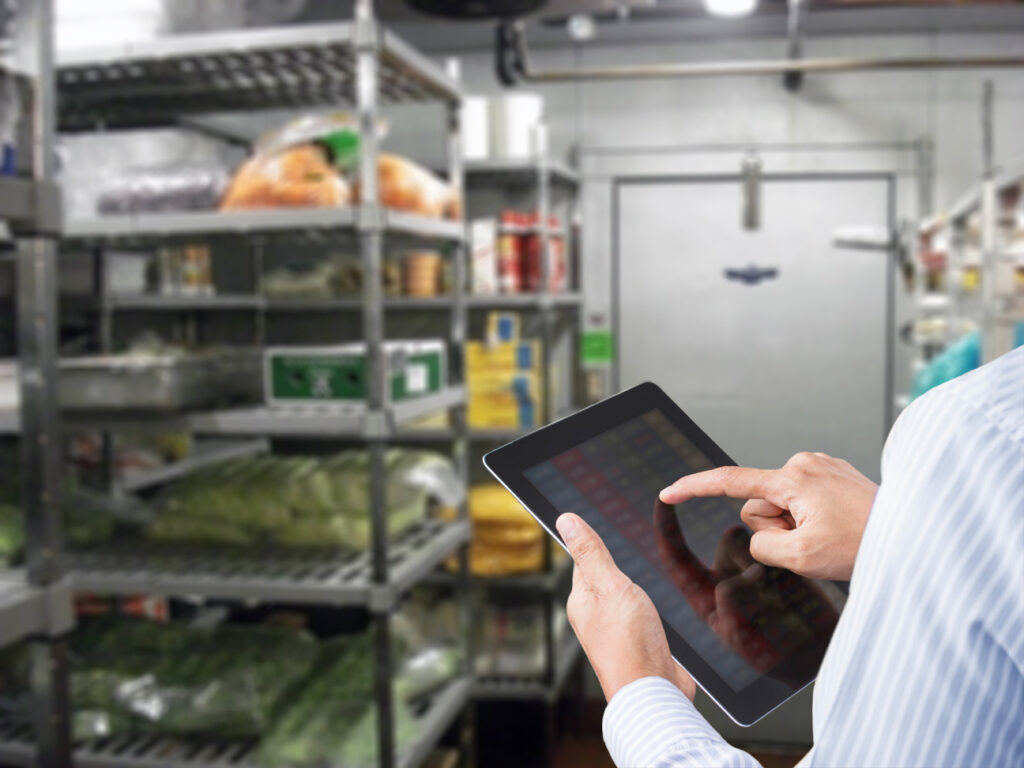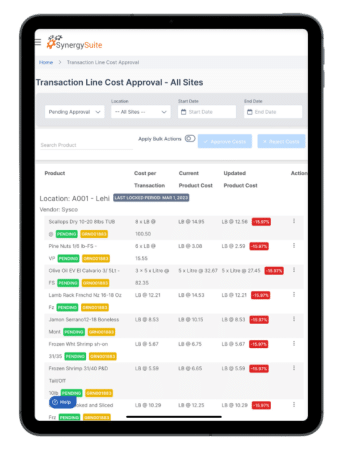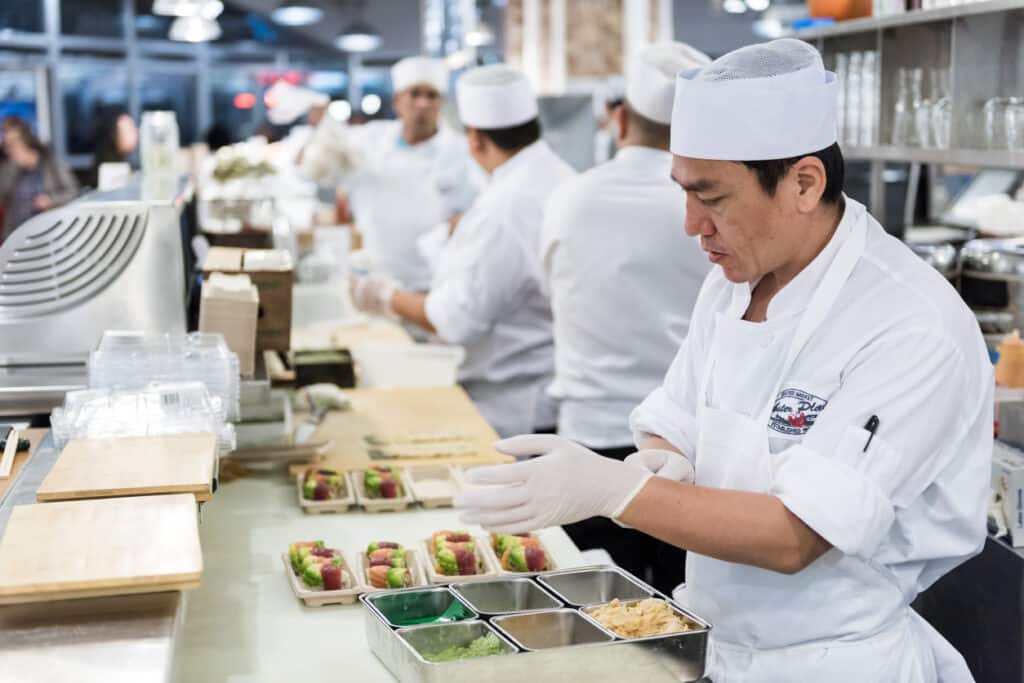An all-in-one restaurant management system encompasses various components that work together to streamline and optimize different aspects of restaurant operations. The beauty of a quality restaurant management system is that all the different components work together to make every aspect better and more useful to restaurant business owners and operators.
In this article, we dive into the different aspects of a quality restaurant management system, and discuss how each piece helps to serve the others.
How the Different Components of a Restaurant Management System Work Together for the Best Results
Throughout this article, we’ll move through different areas of a restaurant operation, and share how each piece of a restaurant management system, designed to solve specific challenges in a restaurant business, works together with all the other aspects of the software.

Inventory and Purchasing Management
Inventory and purchasing management plays a critical role within the full suite of restaurant management system tools as it is interconnected with various aspects of restaurant operations. Here’s how inventory management interacts with other components:
Purchasing and Vendor Relations
Inventory management and purchasing go hand in hand. By analyzing inventory levels, restaurant managers can determine when and what items need to be ordered. The integration between inventory management and purchasing allows for seamless procurement of ingredients and supplies, automating the purchasing process based on inventory levels and pre-set reorder points. This ensures that the restaurant has the necessary inventory on hand while minimizing overstocking or stockouts.
Restaurant Operations
Accurate inventory management is essential for efficient restaurant operations. Real-time tracking of inventory levels enables restaurants to optimize menu offerings and avoid ingredient shortages or wastage. The integration between inventory management and restaurant operations enables managers to monitor stock availability and make informed decisions regarding menu offerings, specials, and promotions. It ensures that the kitchen staff has the necessary ingredients to fulfill orders and reduces the risk of serving out-of-stock items.
Restaurant Analytics & Reporting
Inventory data provides valuable insights for restaurant analytics and reporting. By analyzing inventory usage, costs, and trends, restaurant owners and managers can identify areas of improvement, optimize menu pricing, and forecast demand. The integration between inventory management and analytics allows for the generation of comprehensive reports on inventory turnover, ingredient costs, and profitability. This data-driven approach helps in making informed decisions to reduce waste, manage costs, and increase overall profitability.
Food Safety Systems
Effective inventory management is crucial for maintaining food safety and quality. Through diligent inventory monitoring, including expiration dates and storage conditions, restaurants can ensure compliance with food safety regulations and avoid serving expired or spoiled ingredients. The integration between inventory management and food safety systems allows for automated tracking of product shelf life, temperature monitoring, and adherence to Hazard Analysis and Critical Control Points (HACCP) guidelines. This helps in preventing foodborne illnesses, reducing waste, and maintaining consistent food quality.
Cash Management
Inventory management directly impacts cash management, particularly in terms of cost control and revenue generation. By accurately tracking inventory levels and costs, restaurants can effectively manage their food costs, reduce food waste, and improve overall profitability. This information feeds into cash management systems, enabling accurate financial reporting, cost analysis, and budgeting. The integration between inventory management and cash management ensures that inventory-related expenses and revenues are accurately recorded, providing a holistic view of the financial health of the restaurant.
Accounting and Financial Management
Vendor and purchasing data are essential for accurate accounting and financial management. Integrated purchasing and accounting systems ensure seamless flow of information related to invoices, payments, and cost allocation. This facilitates accurate financial reporting, cost analysis, and budgeting. By automating and streamlining purchasing processes, restaurants can improve cost control, reduce errors, and optimize cash flow management.
Integrating inventory and purchasing management with the full suite of restaurant management system tools, businesses can streamline their operations, optimize inventory levels, reduce costs, enhance food safety, and make data-driven decisions. The seamless flow of information between these components facilitates efficient procurement, menu planning, operations management, financial analysis, and compliance, leading to improved profitability and customer satisfaction.

Labor and Employee Scheduling
Labor and employee scheduling is a critical component of restaurant management, and its integration with other tools in the suite enhances operational efficiency and workforce management. Here’s how labor and employee scheduling interplays with the rest of the tools:
Restaurant Operations
Effective labor management and employee scheduling are essential for smooth restaurant operations. By aligning staffing levels with forecasted demand, restaurant owners and managers can optimize labor costs while ensuring adequate coverage during peak hours. Integrated labor and employee scheduling systems enable seamless communication between management and staff, facilitating the creation and adjustment of schedules based on real-time data, employee availability, and skill sets. This helps in avoiding understaffing or overstaffing situations, maximizing productivity, and delivering a high level of service.
Time and Attendance
Labor and employee scheduling is closely tied to time and attendance tracking. Integrated systems allow employees to clock in and out digitally, ensuring accurate recording of work hours. This data can be automatically synced with the scheduling system, providing real-time visibility into actual hours worked, overtime, and attendance patterns. Integration with time and attendance systems streamlines payroll processing, reduces manual errors, and ensures compliance with labor laws and regulations.
Restaurant Analytics & Reporting
Labor data is a valuable source of insights for restaurant analytics and reporting. By analyzing labor metrics, such as labor costs as a percentage of sales, labor efficiency, and schedule adherence, restaurant owners and managers can optimize scheduling practices and identify opportunities for cost savings. Integrated labor and analytics systems provide comprehensive reports and dashboards, enabling data-driven decision-making to improve labor productivity and control labor expenses.
Restaurant HR and Payroll Solutions
HR software and payroll functions are strongly connected with labor and employee scheduling. Integrated systems allow for seamless sharing of data between scheduling, HR, and payroll software. This integration ensures accurate calculation of wages, benefits, and deductions based on scheduled hours and actual time worked. It streamlines payroll processing, minimizes errors, and saves time for HR and payroll administrators.
Communication and Employee Engagement
Integrated labor and employee scheduling systems often include communication features that enable efficient communication between management and staff. This facilitates better coordination, shift changes, and the ability to notify employees of schedule updates or shift openings. Effective communication and engagement contribute to employee satisfaction, morale, and overall productivity.
Restaurants can optimize workforce management, improve operational efficiency, and enhance employee satisfaction, simply by integrating labor and employee scheduling with other tools in the restaurant management system. The seamless flow of data between systems enables accurate scheduling, better labor cost control, streamlined payroll processing, and data-driven decision-making. Ultimately, this integration empowers restaurant owners and managers to optimize labor resources, deliver exceptional customer service, and drive business success.

Restaurant Analytics & Reporting
Restaurant analytics and reporting play a crucial role in the overall performance and success of a restaurant, and their incorporation with other tools in the management suite enhances decision-making, operational efficiency, and business growth. Here’s how restaurant analytics and reporting interplay with the full suite of tools:
Inventory Management and Purchasing
Integrated analytics and reporting systems provide valuable insights into inventory levels, usage patterns, and purchasing trends. By analyzing inventory data, restaurants can optimize their stock levels, reduce waste, and streamline purchasing processes. This allows for real-time tracking of inventory, generating reports on stock levels, ingredient usage, and cost variances. This information enables informed purchasing decisions, improves inventory forecasting, and ensures optimal inventory management.
Labor and Employee Scheduling
Labor and employee scheduling systems co mingle with restaurant analytics and reporting to provide valuable insights into labor metrics, such as labor costs, labor efficiency, and schedule adherence. By analyzing labor data, restaurants can optimize staffing levels, reduce labor costs, and improve employee productivity. Unification with employee scheduling systems enables accurate tracking of scheduled hours, actual hours worked, and labor expenses. It helps in identifying labor trends, optimizing shift schedules, and improving labor forecasting.
Sales and POS Systems
Analytics and reporting systems seamlessly integrate with sales and POS systems to provide comprehensive insights into sales performance, customer behavior, and revenue trends. By analyzing sales data, restaurants can identify peak hours, popular menu items, and customer preferences. Integration with POS systems allows for automatic data syncing, enabling real-time reporting on sales trends, menu performance, and customer ordering patterns. This information helps in making data-driven decisions regarding menu optimization, pricing strategies, and marketing campaigns.
Financial Management
Integration with financial management systems enables seamless data flow between analytics and reporting tools and financial software. This allows for accurate financial reporting, budgeting, and forecasting. Restaurants can generate detailed financial reports, track revenue and expenses, and monitor key financial metrics. By combining financial data with other operational insights, restaurants can gain a comprehensive understanding of their financial performance and make informed financial decisions.
Food Safety Systems
Analytics and reporting systems can mesh with food safety systems to provide insights into compliance, inspections, and incident management. By analyzing food safety data, restaurants can identify areas for improvement, monitor compliance with regulations, and implement corrective actions. Blending with food safety systems allows for streamlined data collection, reporting, and analysis, ensuring that restaurants maintain high food safety standards and mitigate risks.
The integration of restaurant analytics and reporting with other tools in the management suite enables a holistic view of the business, facilitates data-driven decision-making, and empowers restaurant owners and managers to optimize operations, enhance customer satisfaction, and drive profitability. The seamless flow of data between systems enables comprehensive analysis, reporting, and visualization of key performance indicators, empowering stakeholders to make informed decisions and take proactive measures to achieve their business goals.

Restaurant Operations
Restaurant operations are at the core of a successful food service business, and the interplay between restaurant operations and the full suite of management tools is essential for streamlined workflows, improved efficiency, and enhanced customer experiences. Here’s how restaurant operations interplay with the various tools:
Inventory Management and Purchasing
Restaurant operations heavily rely on effective inventory management and purchasing practices. By integrating with inventory management and purchasing systems, restaurant operations can streamline the procurement process, track stock levels, manage vendor relationships, and optimize inventory usage. Accurate inventory data and real-time insights allow for efficient stock replenishment, cost control, and prevention of stockouts or overstocking. Seamless integration ensures that restaurant operations align with inventory availability and purchasing decisions.
Labor and Employee Scheduling
Smooth restaurant operations require efficient labor management and employee scheduling. The integration of labor and employee scheduling tools allows for optimized shift planning, labor cost control, and effective staff management. By aligning employee schedules with anticipated demand, restaurants can ensure adequate staffing levels, minimize labor costs, and maintain excellent customer service. This ensures that restaurant operations are in sync with labor requirements and employee availability, fostering a harmonious and productive work environment.
Sales and POS Systems
Restaurant operations heavily rely on sales data and POS systems to manage transactions, track revenue, and capture customer preferences. Integration with sales and POS systems enables real-time monitoring of sales performance, menu popularity, and customer behavior. By leveraging this data, restaurant operations can identify trends, optimize menu offerings, and personalize the dining experience. Seamless system communication ensures that operational decisions, such as menu changes, pricing adjustments, and promotional strategies, are based on accurate sales insights.
Financial Management
Effective restaurant operations require strong financial management practices. Integration with financial management systems allows for seamless data flow and accurate financial reporting. By aligning operational data with financial data, restaurant operations can analyze costs, monitor profitability, and make informed financial decisions. Ensuring that operational decisions are assessed in terms of their financial impact and supports effective budgeting, forecasting, and cost control.
Food Safety Systems
Smooth restaurant operations necessitate adherence to food safety standards and regulations. Integration with food safety systems enables efficient monitoring, reporting, and compliance management. By aligning operational practices with food safety protocols, restaurants can mitigate risks, ensure consistent quality, and maintain a safe dining environment. These systems supports real-time data capture, incident management, and proactive measures to address food safety concerns, enhancing operational excellence.
The interplay between restaurant operations and the suite of management tools ensures that key operational aspects, including inventory, labor, sales, finances, and food safety, are seamlessly connected. This integration empowers restaurant owners and managers to make data-driven decisions, optimize processes, and deliver exceptional experiences to customers. By leveraging the comprehensive insights provided by the integrated tools, restaurant operations can drive efficiency, profitability, and sustainable growth.

Food Safety Systems
Food safety is of paramount importance in the restaurant industry, and the interaction between food safety systems and the full suite of management tools ensures that rigorous food safety protocols are seamlessly integrated into restaurant operations. Here’s how food safety systems interplay with the various tools:
Inventory Management and Purchasing
Food safety starts with proper inventory management and purchasing practices. Integrated food safety systems provide tools to track and manage expiration dates, lot numbers, and supplier information. By linking food safety considerations with inventory management, restaurants can ensure that only fresh and safe ingredients are procured, minimizing the risk of foodborne illnesses. Additionally, food safety systems can generate alerts or warnings when inventory falls below acceptable safety thresholds, ensuring proactive actions are taken to prevent food safety issues.
Kitchen Operations and Recipe Management
Food safety systems integrate with kitchen operations and recipe management tools to ensure compliance with standard operating procedures (SOPs) and safe cooking practices. By incorporating food safety guidelines into recipe management, restaurants can establish proper cooking temperatures, cooking times, and food handling instructions. This helps to prevent cross-contamination, maintain safe storage practices, and ensure that food is prepared and served at optimal safety standards.
Employee Training and Certification
Food safety systems collaborate with employee training and certification tools to ensure that staff members are well-trained in proper food handling and safety practices. By integrating training modules, quizzes, and certification tracking, restaurants can ensure that all employees have the necessary knowledge and skills to maintain food safety standards. Integration with employee scheduling tools also helps in assigning appropriate training sessions and monitoring compliance.
Quality Control and Auditing
Food safety systems work in tandem with quality control and auditing tools to monitor and evaluate food safety practices. By integrating quality control checklists, inspections, and audits, restaurants can proactively identify and address potential risks or non-compliance issues. Real-time reporting and analytics provide valuable insights into food safety performance, enabling continuous improvement and adherence to regulatory requirements.
Reporting and Analytics
Food safety systems generate comprehensive reports and analytics to track key performance indicators (KPIs) related to food safety. Reporting and analytics tools allow restaurant operators to monitor critical control points, track compliance metrics, and identify areas for improvement. By leveraging these insights, restaurants can make data-driven decisions to enhance food safety practices, mitigate risks, and demonstrate compliance during regulatory inspections.
The harmonious interaction between food safety systems and the full suite of management tools ensures that food safety considerations are seamlessly woven into every aspect of restaurant operations. By integrating food safety protocols, training, auditing, and reporting into existing management tools, restaurants can foster a culture of food safety, mitigate risks, protect their reputation, and safeguard the health and well-being of their customers. This holistic approach to food safety enables restaurants to deliver consistently safe and high-quality dining experiences.

Cash Management
Cash management plays a crucial role in the overall financial health and operational efficiency of a restaurant. When integrated with the full suite of management tools, cash management systems provide seamless coordination and optimization of cash-related processes. Here’s how cash management interacts with other tools within the restaurant management suite:
Point of Sale (POS) Integration
Cash management systems integrate with POS systems to streamline cash transactions. By connecting directly to the POS, cash management tools automate cash handling processes, such as cash register reconciliation, cash drops, and shift balancing. This eliminates manual errors, improves accuracy, and saves time for staff members.
Inventory and Purchasing
By collaborating with cash management systems, inventory and purchasing tools can track cash flow related to inventory management and supplier payments. By monitoring cash outflows for ingredient purchases and tracking payment cycles, restaurants can ensure optimal cash flow management and maintain healthy vendor relationships.
Sales and Revenue Reporting
Through detailed cash transaction reporting, cash management systems provide insights into sales and revenue. Integration with sales reporting tools allows restaurants to analyze cash transactions alongside other payment methods, enabling comprehensive revenue tracking and accurate financial reporting.
Payroll and Labor Management
Streamlining wage payments to employees, cash management systems can integrate with payroll and labor management tools. By automating cash disbursements for tips, wages, and bonuses, restaurants can simplify payroll processes and ensure timely and accurate compensation for their staff.
Financial Reporting and Analytics
Cash management tools contribute to financial reporting and analytics by providing detailed cash flow data. Integrated reporting and analytics platforms allow restaurant operators to monitor cash flow trends, identify discrepancies, and gain insights into cash-related metrics. This information helps in making informed financial decisions, improving profitability, and managing working capital effectively.
Bank Integration
Cash management systems can integrate with banks to facilitate real-time bank balance tracking, transaction reconciliation, and cash forecasting. By linking the system directly with bank accounts, restaurants can automate cash-related tasks, such as deposits, withdrawals, and fund transfers. This ensures accurate and up-to-date cash visibility, reducing the risk of overdrafts or cash shortages.
Security and Fraud Prevention
Cash management systems work in tandem with security and fraud prevention tools to safeguard cash assets. Integration with surveillance cameras, access control systems, and cash control measures enhances security and helps deter internal and external theft. Real-time monitoring and alerts enable quick detection of irregularities and potential fraudulent activities.
By integrating cash management with the full suite of management tools, restaurants can streamline cash-related processes, enhance financial visibility, and improve operational efficiency. The seamless coordination of cash management with other tools ensures accurate financial reporting, optimal cash flow management, reduced administrative burden, and increased security, ultimately contributing to the overall success of the restaurant.

Restaurant HR and Payroll Solutions
Restaurant HR and payroll solutions play a crucial role in managing the human resources and payroll functions of a restaurant. When integrated with the full suite of management tools, HR and payroll systems streamline employee management, payroll processing, and compliance. Here’s how HR and payroll solutions interplay with other tools within the restaurant management system:
Employee Scheduling
HR and payroll solutions integrate with employee scheduling tools to ensure accurate and efficient scheduling processes. By syncing employee data, such as availability and roles, with the scheduling system, HR and payroll software helps in creating schedules that align with labor laws, employee preferences, and business requirements. This minimizes scheduling conflicts, reduces overtime, and improves workforce management.
Time and Attendance Tracking
Time and attendance tracking tools collaborate with HR and payroll systems to automate the collection of employee work hours. Integration allows for accurate and real-time capturing of clock-in/out data, breaks, and time-off requests. This data is seamlessly transferred to the payroll system, eliminating manual data entry, reducing errors, and ensuring accurate payroll calculations.
Payroll Processing
HR and payroll solutions integrate with payroll processing tools, automating and simplifying the payroll process. Employee data, such as work hours, wages, tips, and deductions, are automatically populated from the time and attendance system, eliminating the need for manual data entry. Payroll software calculates net pay, taxes, and other payroll-related figures, generating accurate and timely paychecks for employees.
Compliance and Reporting
HR and payroll systems provide compliance and reporting features that interplay with other tools in the suite. Integration with labor law compliance tools ensures adherence to legal requirements related to minimum wage, overtime, and employee classification. Payroll data can be seamlessly transferred to reporting and analytics platforms to generate insights into labor costs, payroll expenses, and other key HR metrics.
Employee Self-Service
Often included in HR and payroll solutions are employee self-service portals or mobile apps. These tools allow employees to access their personal information, view pay stubs, submit time-off requests, and update their contact details. Integration with self-service tools enhances employee engagement, empowers employees with more control over their HR-related tasks, and reduces administrative workload for HR staff.
Benefit Management
HR and payroll systems can integrate with benefit management platforms to streamline the administration of employee benefits. This integration automates the enrollment process, tracks benefit deductions, and ensures accurate deductions in payroll calculations. It also provides employees with easy access to their benefit information, including insurance coverage and retirement plans.
Onboarding and Offboarding
HR and payroll solutions facilitate seamless onboarding and offboarding processes for employees. Integration with onboarding tools allows for the automated collection of new employee data, completion of necessary paperwork, and join with payroll systems for seamless employee setup. Similarly, when an employee leaves the organization, this streamlines the offboarding process, including the termination of payroll and benefit-related activities.
Restaurants can streamline employee management, automate payroll processes, ensure compliance with labor laws, and improve operational efficiency and other HR and payroll solutions with the full suite of management tools. The seamless coordination of HR and payroll functions with other tools optimizes workforce management, reduces administrative burdens, enhances employee engagement, and enables accurate and timely payroll processing.
By combining these components into an all-in-one restaurant management system, businesses can smoothly run their operations, enhance efficiency, reduce costs, and improve overall performance. It provides a comprehensive solution that addresses the specific needs of the restaurant industry, enabling seamless management of inventory, purchasing, labor, analytics, operations, food safety, cash handling, and HR functions.
Explore SynergySuite’s Module-Based Restaurant Management System
- Overview of our Restaurant Management Software
- Modules for Operations
- Modules for HR and Employee Management
- Modules for Financial Management
- Mobile Apps for On-the-Go Restaurant Management





